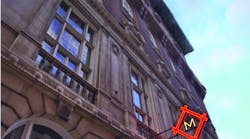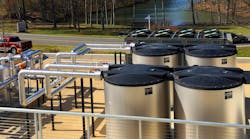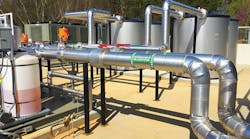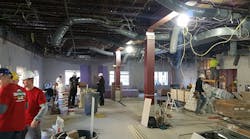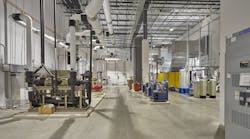by Matthew Mullen, P.E., LEED AP, BEAP, CBCP
The Forman School in Litchfield, Ct. is a coeducational college-preparatory boarding and day school providing education for students with learning differences that will empower them to succeed in college and throughout their lives. The Forman School is for students in grades 9 through 12 and postgraduates who are bright and academically motivated but may have been diagnosed with dyslexia, other language-based learning disabilities, executive function difficulties, or attention deficits that have created challenges for them in the past.
Combining a Design/Build project delivery approach for the Mechanical, Electrical, and Plumbing (MEP) systems with a traditional Construction Management for rest of the project, Forman School successfully reworked a facility that meets its unique program requirements, that was under budget, and that was completed ahead of schedule.
The VPAC project program included a 300-seat auditorium with performance platform, scene shop with prop storage, dressing rooms, a dance studio, a video production suite including a green screen room, a photography suite with a dark room, a jewelry fabrication room, a painting studio, a ceramics room including a pottery kiln, and general classrooms.
SEE THE GALLERY AT UPPER RIGHT AND READ ABOUT ENTIRE PROJECT BELOW
Resting in Design/Build Process
The owner’s representative on the VPAC project, Leland Torrence, had previously worked with EMCOR Services New England Mechanical Services (NEMSI) on smaller Design/Build mechanical and electrical projects. In the fall of 2015, Leland reached out to NEMSI’s Vice President of Engineering and Design, Matthew Mullen P.E., for suggestions for local mechanical/electrical/plumbing consulting engineers to work with an out of state architectural firm that had been already been engaged for an unidentified but good sized project in Connecticut. During the course of the discussion, Mullen inquired if they had considered utilizing a Design/Build approach for the project. Torrence suggested NEMSI contact the architect to discuss the idea.
NEMSI contacted the project architect and discussed the possibility of a Design/Build approach for the MEP systems. Coincidentally, the project architect had recently successfully completed some residential projects using a Design/Build project delivery approach for their MEP systems.
The Forman Building Committee was initially hesitant to employ a Design/Build form of project delivery for the MEP systems. The Building Committee was concerned about how they could control performance and cost or who would serve as the “watchdog” with a Design/Build approach. The budget estimates for the overall VPAC project were significantly over the available budget at this point in project development. NEMSI was asked to assist the design team, Owner’s representative, and Forman Building Committee to develop holistic solutions for cost reduction on the project. NEMSI’s efforts, through this cost reduction process, was demonstrated by their commitment to performance, budget control, and a cooperative team attitude.
The diverse nature of the activities in the building, the extensive use of natural sunlight through skylights and large windows, low noise criteria in the auditorium as well as the classrooms, and a stated desire for good temperature and humidity control drove the HVAC design solution to a central air cooled chiller system serving variable air volume (VAV) air handling units.
The classroom wing has VAV terminal units with hot water reheat coils. The classroom wing of the building is a wood frame construction with sheet rock or wood paneled ceilings. If the VAV terminal units were to be installed in the ceiling, access doors would be required throughout the building. Access panels in these ceilings were considered objectionable by the entire design team. To overcome the lack of terminal unit access, a platform mechanical space was created in the attic with a set of pull down stairs for access. All eight terminal units serving the upper floor were installed on this platform. All service and maintenance for these terminal units is now centralized in a readily accessible space eliminating the need for access doors throughout. Similarly, all but one of the terminal units for the lower floor were centralized in the basement mechanical room where the main air handling unit is located.
The auditorium has one large single zone VAV unit and ductwork specially designed for low noise. The Auditorium unit has a special performance mode that can convert the unit to a constant flow unit for the duration of a performance. The performance mode will eliminate any variation in air flow which can eliminate cold air “dumping” on the audience or slight acoustic changes as the air volume changes. The operation of the unit as a single zone VAV unit provides for energy efficiency during normal operation while the performance mode provides for improved comfort of the audience during large events in the Auditorium.
A constant volume unit was provided for the Platform performance area for the same reasons the Auditorium unit’s performance mode was created: improved comfort and no changes in unit noise. The platform unit and air distribution system was designed to provide a NC-25. The air velocities discharging from the custom fabricated diffusers are extremely low in order to meet this criteria. If the unit was a single zone VAV unit at part load operation, the diffuser discharge velocities would be to low to provide adequate air movement and comfort for occupants on the platform. Therefore, to insure proper air circulation and comfort on the Platform, the design decision was made to leave the unit as a constant volume unit.
The Forman School, Litchfield, Ct.
Completed by EMCOR New England Mechanical Services, Inc.
Mechanical Project Manager – Wayne Pare
Plumbing and Piping Foremen – Joe Pasqua and Fred Manuel
Sheet Metal Foreman – Tony Bravo
Electrical Project Manager – John Dundon
Electrical Foreman – Caleb Fox
Project Engineer – Matthew Mullen, P.E., LEED AP, BEAP, CBCP
Project Designer – Bryan Urban
Project Drafting & Fabrication – Jay Higley
Project Commissioning – Daniel Cowan, CEM
EQUIPMENT SELECTIONS
HVAC:
Boilers – Laars NeoTherm Model NTH399
Air-Cooled Chiller – Trane Model CGAM
Pumps – Armstrong Dual Arm DE-IVS,
Air Handling Units – Trane Performance Climate Changer Models UCCAH, CSAA and BCHD
Variable Air Volume Boxes – Trane VCWF and VPWF
Diffusers – Krueger Model 5SHR, DMGDU
Building Automation System and Temperature Controls – Delta Controls EnteliWeb
Plumbing:
Water Closets and Lavatories – Toto High Efficiency EcoPower
Lavatory Faucets – Delta 523LF-HDF
Water Fountains – Haws Model 1011 and 6700
Classroom Sinks – Elkay Pacemaker Stainless Steel with Elkay Model LK500HA1076 Faucets
Domestic Water Heaters – HTP Model EVC020 and EVC115
Photography Sink – Griffin Products MS-248
The consultant recommended a number of physical modifications to the school’s auditorium architectural configuration, added an extensive catwalk to both the auditorium and the platform, and added provisions for a significant theater lighting system.
Another interesting challenge was designing an exhaust hood for the jewelry classroom soldering operations. Students would be soldering in two dedicated locations on top of fixed casework. The challenge was to design a functional, cost effective and aesthetically acceptable exhaust system that didn’t limit access to the working area or did not present a safety hazard to the students. NEMSI designed a custom stainless steel exhaust hood with sloped face and exhaust grille. The sloped face minimizes the depth of the hood on the table to minimize the encroachment on the work surface, provides capture velocities to adequately capture the soldering fumes and does not present a safety hazard for students.
One design complication was the glass walled lobby. While very attractive, the glass walled lobby with wood panel ceilings attached to structure made it difficult to run HVAC and plumbing utilities between the two wings of the building. Since most of the building had the ceilings attached to the bottom the structure, there was no space to run pipes, conduits and ductwork below the structure with the exception of a small triangular space at the top of the lobby and above the single egress corridor in the classroom wing. Close coordination with MEP systems and fire protection systems was required to fit all the necessary utilities into the small space available.
The building mechanical systems were designed to operate efficiently through the following DDC control schemes:
• Demand control ventilation to minimize the amount of outside air in response to the number of occupants on all units.
• Critical Zone Reset of the static pressure and discharge air temperature on the classroom wing variable air volume air handling unit.
• Optimized start/stop scheduling for all air handling units.
• 130F design hot water temperature with 30F temperature differential to maximize efficiency of condensing boilers as well as minimize pipe sizes.
• Variable flow hot water and chilled water pump systems.
• Daylight harvesting and vacancy occupancy sensors on lighting control system.
After the HVAC systems were complete, EMCOR had their in-house commissioning specialist, Dan Cowan, commission the HVAC systems. The commissioning process uncovered a number of issues including:
• An erroneous set-up parameter in the self-sensing pump controllers created low flow during high loads in the hot water system.
• Random changes in the chilled water pump operation were discovered and attributed to a bad circuit board in the chilled water pumps controller.
• A strainer concealed under insulation on the air cooled chiller was clogged with paint chips and dirt restricting the chilled water flow in the system.
• The temporary filters over the return air grilles (to protect from sheet rock dust and wood dust from finish carpentry) were extremely dirt requiring the air handling unit run at a higher than necessary speed during balancing. The temporary filters were changed and the system was rebalanced to achieve its design airflow rate.
• The unoccupied set-up temperature and relative humidity setpoints were causing the air handling units to go into dehumidification almost immediately. Simple setpoint adjustments were made to resolve this issue.
Throughout the process of building the VPAC, the Forman building committee applied of its own core principles by
embracing a different project delivery styles to meet the project challenges head-on that resulted in a wonderful and comfortable facility that meets its original programmatic goals. The Forman School VPAC ultimately provides an environment where students are encouraged to be happy, engaged, and ultimately, successful.


